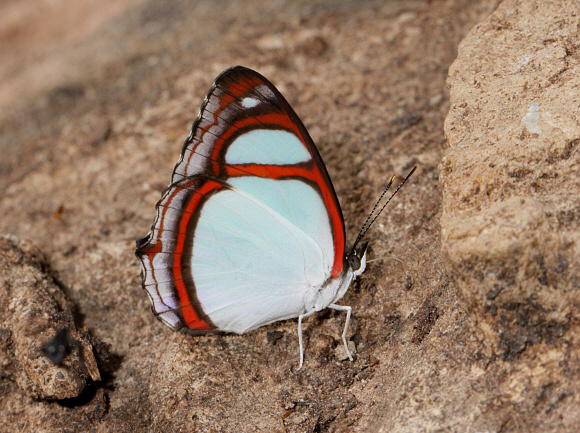 Pyrrhogyra crameri, Satipo, Peru – Adrian Hoskins
Pyrrhogyra crameri, Satipo, Peru – Adrian Hoskins
Introduction
The genus Pyrrhogyra includes 6 known species, all marked on the underside with large white areas enclosed within rings that are formed from narrow red lines. An unusual and notable feature is that the butterflies also have red eyes.
All Pyrrhogyra species are very similar in appearance. They can be distinguished from one another by carefully examining the markings around the underside hindwing margins and by comparing the size and shape of the greenish-white areas on the dark brown uppersides.
The butterflies are exclusively neotropical, some species being found as far north as Mexico, and others as far south as Bolivia and Paraguay, but the state of Amazonas in Brazil probably has the highest diversity of species.
Pyrrhogyra crameri is found from Nicaragua to Peru.
Habitats
This species breeds in forested habitats at altitudes between sea level and about 1200m.
Lifecycle
The eggs are white and shaped like flattened cones. They are laid singly on the leaves of Paullinia or Serjania ( Sapindaceae ).
The larva is dull amber in colour with black dorsal spines, and is superbly camouflaged when at rest on young Paullinia leaves.
The pupa is green with brown wing cases. It is attached by the cremaster to a pad of reddish silk on the upper surface of a leaf, from which it projects laterally.
Adult behaviour
Males are usually encountered singly or sometimes in two’s or three’s when imbibing moisture from urine-soaked sand, dung, damp rocks or wet foliage in forest edge habitats.
In late morning small groups of males sometimes perch in close proximity on foliage in light gaps or along forest edges. They commonly indulge in brief but frenetic territorial battles, after which each male returns to it’s original perch for a few moments before racing off on another aerial sortie.
Females are seen less frequently, usually when basking on low foliage between egg-laying sessions, or when visiting flowers.
If disturbed the butterflies fly off rapidly, and hide upside-down beneath leaves on bushes or young saplings, usually no more than a metre from the ground. They also go to roost in similar situations overnight or in dull or wet weather.
